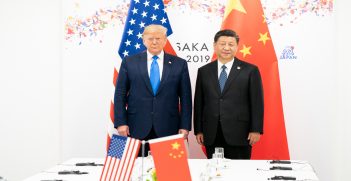Internationalisation of Chinese SMEs: Trends and Implications

An increasing number of Chinese small-medium enterprises (SMEs) are expanding internationally. While global platforms serve as the driving forces of Chinese SME internationalisation, an institutional escape perspective provides unique insights into this prominent phenomenon in the global marketplace.
In the past two decades, one noticeable global phenomenon is that SMEs from emerging economies and particularly from China are increasingly participating in international markets and becoming part of the world economy. Internationalisation can be defined as the process of adapting a firm’s operations to international environments, geographically expanding a firm’s network of relationships, or a pattern of entrepreneurial behaviour. When compared to developed market firms, emerging market SMEs often follow a different internationalisation process, and have different motives, and demonstrate unique paths. Such differences exist thanks to differential institutional, industry, and resources factors between developed and emerging markets. For example, institutional vulnerability such as ambiguous property rights protection, poor law enforcement, and corruption in public services and industry are common in China as compared to advanced economies. In addition, as a resource, social networks (e.g., business and political ties) are considered more important in China. Accordingly, Chinese SMEs internationalise for three main reasons: to exploit new niche markets, to obtain knowledge that can enhance their competitiveness domestically and overseas, and to learn from and potentially replicate the strategies of large multinational corporations (MNCs).
Platform-based internationalisation of Chinese SMEs
Unlike large MNCs, Chinese SMEs face significant resource pressures; their internationalisation efforts are impeded due to financial, technological, reputational, and knowledge constraints. While Chinese SMEs continue to use larger firms’ networks to tap into multiple country markets, platforms, such global digital ones, are emerging as an important vehicle for them to enter global markets at speed and at a scale unimaginable in the past. Such digital intermediaries provide Chinese SMEs a level playing field, credibility, cross-border networks, and direct access to market information. Digital platforms also provide them a virtual field, unconstrained by space and time limitations, directly engaging with diverse international customers to achieve rapid internationalisation and value creation.
Specifically, some platform assets enable their internationalisation. Digital assets are the key building blocks of global platforms; these digital assets, at their core, exhibit modularity and malleability. Digital characteristics of modularity and malleability enable efficient deployment and recombination across various digital technologies or complementary digital assets. In addition, the modularisation of digital assets allows Chinese SMEs to be centralised, protected, flexible, and open enough to fast bundle with their network partners’ complementary assets. Indeed, platform modularity is integral to conceiving the generative potential of platform resources in enabling diverse business models. For example, the inherent modularity of Amazon’s platform allows resource configurations that deliver multiple business models, including product marketplaces, subscription service marketplaces (e.g., Prime video), and Amazon web services (AWS).
Unique Chinese SME internationalisation: Institutional escape
While global platforms enable them to explore the global marketplace rapidly and effectively, Chinese SME internationalisation is closely associated with institutional escape. Conceptualised as an escape response to the actual and perceived misalignment between firm needs and home country institutional environments, this perspective offers a unique approach to understanding Chinese SME internationalisation as institutional arbitrage. By arbitraging differences between national institutions, they venture abroad as an escape response to domestic institutional imperfections and, at the same time, align their needs with appropriate institutional conditions abroad, and seek institutional resources to their advantages. Such institutional resources include better property rights protection, less corruption in public services, and more tractable industry regulation which Chinese private firms can often access and obtain in overseas and especially advanced markets.
Since the 1990s, China has been embracing a state-capitalist model, putting a heavy emphasis on political and financial controls and favouring state-owned enterprises (SOEs) at the expense of private sector actors. In the Chinese context, the statist institutional environment generates an institutional hindrance that limits the perceptions and opportunities of Chinese private firms and especially SMEs, who escape to venture abroad for possible institutional alternatives. Hence, international venturing provides them with some buffer against domestic policy discrimination. Not surprisingly, the booming period of the internationalisation of Chinese private firms coincided with the massive stimulus package that the government took after the 2008 global financial crisis. With an estimated 90 percent of the funds going to SOEs, the stimulus program led to the crowding-out of Chinese private firms and particularly SMEs, forcing them to venture abroad. In the same vein, at a relatively early stage of internationalisation, many Chinese private firms, such as Glanz and Fuyao Glass, aimed to escape the costly business environment in China.
It is important to recognise that institutional escapism for Chinese SMEs may not necessarily be an internationalisation model of total transfer from home country to host country; SME internationalisation may be partially a response to home country institutional constraints. The low labour cost and relatively low price of production are competitive advantages for many SMEs to compete with MNCs. With operations in a familiar local environment, some Chinese SMEs could encounter the disadvantage of selling and distributing products and services in home markets dominated by SOEs who are better aligned with domestic institutional demands. The escapism for these SMEs is primarily exit from their home country by selling their products and services in overseas markets, thus starting their meaningful international activity on the exporting side.
Practical and policy implications
The above discussions provide some important implications for both practitioners and government policy-making. One of the major practical implications especially for SMEs and their founders and managers is that an understanding and assessment of the extent of institutional diversity across national borders is critical to the success of their venturing overseas due to institutional escapism. With a clear understanding of institutional diversity of national economies, SMEs may act as institutional entrepreneurs, arbitraging cross-country institutional differences as a remedial measure for detrimental, domestic institutional demands. In this sense, institutional escapism may also constitute a novel form of entrepreneurship, which provides insights into SMEs’ awareness of, access to, and exploitation of national comparative institutional advantage. However, these benefits are not automatic, nor are they riskless; SMEs need to develop and strengthen their arbitraging capability and capitalise on these institutional sources of advantage by consciously taking advantage of global platforms which enable SMEs to easily access their “plug-and-play” capabilities, thus creating a more level playing field for them to compete worldwide.
SMEs may need to continually reappraise their institutional instruments, as indeed may national governments. To make an optimal use of the institutional resources within their jurisdiction, governments need to ensure that their regulations would help support and enhance the increasing importance of institution-facilitated infrastructure, which involves a greater appreciation of the changing locational requirements of exporting and investments. Accordingly, differences in institutional environments between countries are compelling firms to prioritise their location strategy on the basis of the attractiveness of countries, regions, or communities, defined by a complex set of institutional parameters in the relation to the global marketplace.
Ping Deng is a professor of management at the Monte Ahuja College of Business, Cleveland State University, Ohio, USA. His research interests are innovation, entrepreneurship, and foreign direct investment, with a focus on emerging economies. His research profile is accessible at Ping Deng – Google Scholar.
This article is published under a Creative Commons Licence and may be republished with attribution.




